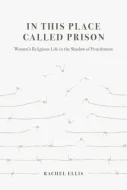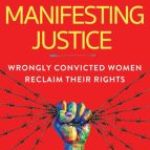In This Place Called Prison: Women’s Religious Life in the Shadow of Punishment
Author: Rachel Ellis
Publisher: University of California Press, 2023. 280 pages.
Reviewer: Lynsey Black | January 2024
Rachel Ellis’ recently published monograph focuses on how religion and religious practice infuse the experience of women’s imprisonment in the contemporary United States, presenting a compelling interpretation of how religious life bends and adapts to the prison regime. Ellis introduces the reader to Mapleside women’s prison, drawing on one year of ethnographic research, during which she conducted interviews with imprisoned women, criminal justice professionals, and religious volunteers. Across hundreds of hours, Ellis engaged in the daily life of the prison and the practice of religious life within its walls. This ethnographic approach is vital; Ellis’ time spent observing, chatting, and working alongside incarcerated women offers a convincing portrait of the meanings and realities of religion as it exists within the carceral web. Towards the book’s close, Ellis reveals that academics frequently pressed her as to why she had confined her study to ‘just’ religion. Yet it is clear that in focusing on religion, the study opens up and reveals much about a lot. The book is arranged across an introduction, five substantive chapters, and a conclusion that offers three key takeaways. The book closes with a fascinating coda on the re-entry experiences of some women who have since left prison and a methodological note.
The introduction provides a succinct round-up of the scholarship in the field and sets the parameters of the current study. Mapleside is a publicly-funded state prison on the East Coast with around 1,000 imprisoned women, roughly similar numbers of whom are White and Black, and a smaller number of whom are Latina. Considering its historical and political origins, Ellis offers a snapshot of religion and punishment in the United States. The introduction also explains how religious preference is negotiated within prison bureaucracy and the variations on this from state to state: while in Virginia, you may convert your religious preference up to four times a year, in Montana, you must restrict your religious conversion to just once annually. In Mapleside, 63% of the incarcerated women identified as Protestant (encompassing the many flavors of Protestantism). The next largest group in the prison was Catholic, accounting for 7% of women, followed by Sunni Muslims, accounting for 5% of women. Only 2% of women declared ‘No religion’ on their entry forms.
Chapter 1, ‘Thou Shalt Not,’ sets the scene, introducing the numbers, trends, and themes of women’s imprisonment in the US and bringing the reader through a day in the life of Mapleside. For decades, the US has experienced a period of mass incarceration. However, although men’s incarceration rates appear to have peaked, the rates for women remain high. Women are 7.5% of all those held in state or federal prisons, totaling approximately 200,000 women on a given day. As we know, incarcerated women are not drawn evenly from all corners of American society, instead coming disproportionately from marginalized, poor, and racialized groups. Emphasizing the ways in which carceral control functions, Ellis illustrates the extent to which the regime dehumanizes, infantilizes, and degrades. One woman, discussing the requirement that the administration be informed of any hairstyle change, explains this as ‘we’re property of the state’ (p.39). ‘Carceral control is all-encompassing by design’ (p.36), down to the women’s hairstyles.
Chapter 2, ‘Let There Be Light,’ introduces religious life in Mapleside, setting out the various religious programs and the employees and volunteers facilitating them. Religious programs far outnumber secular programs in prison. In the neoliberal political moment, religious programming presents a cost-effective option for states that increasingly rely on volunteers to deliver ‘content.’ A frequent theme of the book is how financial considerations have informed both prison programming and incarcerated women’s lives. We learn that the chaplain designed t-shirts that women can purchase and wear at Sunday service. It is $10 for a t-shirt, a sum of money that seems exploitative when $10 is a day and a half of the women’s work. Yet religion also provides respite. Alternative clothing gives visual relief from the usual khaki. Even the carpet in Chaplain Harper’s office offers comfort in an otherwise sterile environment. In addition to aesthetic novelty, religious practice also affords incarcerated women a degree of autonomy in a highly structured regime (p.61-62 demonstrate how Maria oriented her day around religious activities).
Consideration of the role of religious volunteers continues a long tradition in writing on women’s prisons, which has examined how class manifests. In the historical literature, we are familiar with the benevolent lady visitors of the Victorian prison, yet we know little or nothing about how women viewed these visitors. Ellis’ work provides a snapshot of incarcerated women’s opinions on these frequently middle-class volunteers. As one incarcerated woman rightly notes, these volunteers are not qualified social workers or counselors; they present at the prison with their own problems and reasons for giving their time. As Ellis witnessed, despite their lack of training, these volunteers also frequently respond to the deeply traumatic experiences that incarcerated women may confide in. Additionally, Ellis notes that volunteers undergo a process of ‘secondary prisonisation’ (Comfort, 2008). Ellis argues that while religious practice offers certain freedoms to incarcerated women, the shape that religion takes in prison is reworked by state control.
Chapter 3, ‘The Lord is my Shepherd,’ explores how women’s personal narratives are intertwined with religious messages of redemption. There is a strong current of responsibilization within Protestantism, which ensures a certain discursive compliance with the criminal justice system. Ellis shows how religion can offer comfort and make prison meaningful for incarcerated women. Yet these narratives are only ever located at the individual level. As Ellis argues, this religion veers away from calls to collective action. Ellis presents various examples in which ‘religious logics served to naturalize the prison’s rules and affirm the authority of state actors’ (p.103), instances where women accepted the deprivations of prison and took them as a test of faith. One woman, Heather, was caught attempting to sneak new trainers into the prison. Heather should have purchased new trainers through the prison’s private vendor, but she could not afford to buy the trainers at this elevated cost. For her infraction, Heather was penalized with 200 days in solitary. The night before her hearing, her religious atonement convinced her not to fight the charge. In reading this, it is difficult not to feel anger at both the system itself and the passive form religion takes within it.
Chapter 4, ‘Blessed is the Fruit of thy Womb,’ examines the incarcerated women as women and as mothers, comparing the state correctional narratives with alternative meaning-making in religious discourse. When women are judged by criminal justice actors, their womanhood and motherhood are typically found wanting. Consequently, when the women themselves attempt to cite motherhood, such as when arguing for parole, their motherhood is dismissed as something they exploit for their own interests. In looking at religious programming, Ellis outlines the extent to which these volunteers also dealt with the incarcerated women as women. Unlike state actors, however, religious volunteers do not damn the women as failures. Yet, the messaging does skew towards the traditional, for example, in the exhortation that women should submit to men. In her consideration of sexuality, Ellis attempts to avoid the path of earlier scholarship, which objectified same-sex relationships in prison, dubbing them as either a form of resistance or a matter of making do. She relays the fascinating juxtaposition of religious worship and romantic coupledom in the opportunity that a church service can present to take a moment together. In this, we also see the distaste of some of the other incarcerated women, as well as from the religious leaders in the prison. Such judgment had weighed heavily on the women who had renounced their sexuality on entry to prison following their conversion to religious faith. Nevertheless, there were also moments of resistance to the religious doctrine of heteronormativity. Rebecca, for example, refused to tolerate the judgment of her marriage to a woman and converted to Lutheranism, sensing it presented a less judgemental environment.
The pains of motherhood in prison are illustrated in this chapter also. Ellis recites the numbers – one in every 20 women will be pregnant during their incarceration. Some women will give birth while still in shackles. When their children are born, they will spend around 24 hours with the newborn before they are separated. Less than half (42%) of women in state prisons ever receive a single visit from their children. Laura considered herself lucky that she had been allowed three days with her baby before they were separated. She had given birth on a Friday, and the social worker wasn’t available over the weekend. At Mapleside, mothers with young children have some accommodations, including a special space in the Main Hall available during visits. Laura could see two of her four children in this way but explained that her son had been sad when he ‘aged out’ of this area at three years old while his two younger sisters could still visit with their mum here. The logistics of a visit itself are daunting for family members who are willing and able to travel. Laura detailed, for instance, that the prison would not tolerate dirty diapers in the bins, meaning that her partner took them to a McDonald’s afterward to dispose of them before the long drive home. The women’s lives in prison are punctuated with such seemingly surreal and senseless cruelties.
In this environment, Chaplain Harper’s introduction of a baby doll as a therapeutic tool sparked an intense reaction from many incarcerated women. Things went well for a month, until a religious volunteer saw the love being lavished on the doll, and chided the women to take comfort in Christ and not an object. The description of one particular woman’s anguish at the removal of the doll is a horrific read. The pitiful transferral of affection to a doll throws up questions about the harm to women and children and the infantilization of adult women in prison, many of whom are mothers separated from their children.
Chapter 5, ‘For Many are Called, but Few are Chosen,’ examines status and dignity in prison. The study focuses on religious life in a women’s prison, yet this almost inevitably meant a focus on Protestant religion, which dominates religious programming. This has knock-on consequences for women who are not of this faith. Within Protestantism, the elevation of “incarcerated acolytes” as church officials creates immediate divisions between women regarding privileges and autonomy. Beyond Protestantism, women of other faiths, such as Muslim or Jewish women, find themselves with fewer advantages by virtue of their minority status. In a prison environment where women must compete for scarce resources, these discriminations spark resentment and have outsized consequences.
Concluding, Ellis elucidates three lessons she has taken away from her experience of Mapleside. First, words matter. The narratives of imprisonment are those of failure and degradation. Religion offered incarcerated women an alternative self-narrative that could incorporate redemption and meaning. Secondly, best intentions are not enough. Volunteers entered prison with benevolent goals, but religion was inevitably subject to the coercive needs of the regime. Finally, religion is central, not peripheral, to punishment in the US today. Unlike secular programming, religion in prison competes with the state for institutional primacy. Its dominance rests on three factors: ‘the historical linkages between religion and punishment, contemporary constitutional protections of religious practice in US correctional facilities, and the … need to secure voluntary programming when state funds are tight’ (p.167). As such, religion could be a vehicle through which some of the deprivations of the system are alleviated if, for example, funding was provided to ensure equal coverage for women of all faiths. Yet, as ever, prison religion seems resolutely stuck to the individual, eschewing the structural and the political. Ellis’ piercing study, beautifully written, vividly demonstrates the double-edged sword of religion in prison – its capacity to liberate and its equal power to subjugate. One of the conceptual achievements of the work is the idea of ‘secondhand carcerality,’ ‘a reiteration of carceral control by a noncarceral actor that occurs via contact with the criminal legal system’ (p.5). Throughout, Ellis demonstrates the extent to which religion and the carceral state compete for dominance and work in alignment to instill the personal responsibility of rehabilitation.
Lynsey Black is a Lecturer in Criminology at Maynooth University.



